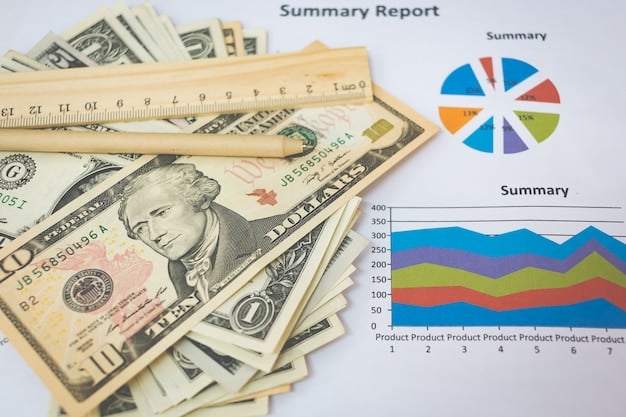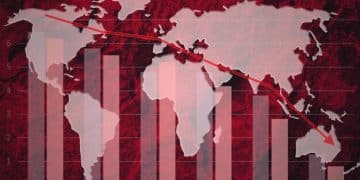The Future of the US Dollar: Is Reserve Currency Status at Risk?

The future of the US dollar as the world’s reserve currency is under scrutiny due to factors like rising debt, geopolitical shifts, and the emergence of alternative currencies. Understanding the challenges and opportunities is crucial for investors and policymakers alike.
The global financial landscape is constantly evolving, and one of the most debated topics is the future of the US dollar and whether it will maintain its status as the world’s reserve currency. For decades, the dollar has been the cornerstone of international trade and finance, but emerging economic powers and alternative financial systems are challenging its dominance.
What factors are contributing to this potential shift, and what could be the implications for the United States and the global economy? Let’s delve into the complexities surrounding The Future of the US Dollar: Is It Losing Its Status as the World’s Reserve Currency? to better understand the forces at play.
Understanding the US Dollar’s Current Status
The US dollar has been the world’s primary reserve currency since the Bretton Woods Agreement in 1944. This means that most international transactions, central bank reserves, and global debt are denominated in dollars. Several factors have contributed to this dominance, including the size and stability of the US economy, the depth and liquidity of US financial markets, and the dollar’s role as a safe haven during times of economic uncertainty.
Historical Context of the Dollar’s Dominance
The dollar’s rise to prominence wasn’t accidental. Post-World War II, the US economy stood as a beacon of stability and growth, while other major economies were rebuilding. The stability offered by the US financial system made the dollar the natural choice for trade and investment. This advantage was further cemented by the petrodollar system, where oil-producing nations agreed to price oil in US dollars, which in turn created consistent global demand for the currency.
Key Benefits of Being the World’s Reserve Currency
Having the world’s reserve currency offers numerous advantages. The US benefits from lower borrowing costs, greater financial flexibility, and the ability to exert influence over global economic policies. Companies in the US can conduct cross-border trade more easily, and American consumers enjoy cheaper imports. Additionally, the demand for dollars helps keep the value of the currency stable, providing a level of insulation from economic shocks.
- Lower Interest Rates: Demand for dollars allows the US to borrow at lower rates.
- Economic Influence: The US can shape global economic policies due to the dollar’s dominance.
- Trade Advantages: Facilitates international trade for US companies.

However, this status is not guaranteed forever. As the global economic landscape evolves, various challenges and potential threats to the dollar’s dominance have emerged. These factors could reshape The Future of the US Dollar: Is It Losing Its Status as the World’s Reserve Currency?
Factors Threatening the US Dollar’s Dominance
Despite its historical strength, the US dollar faces numerous challenges that could threaten its status as the world’s reserve currency. These include increasing US debt, geopolitical tensions, and the rise of alternative currencies and payment systems.
Rising US National Debt
One of the most significant concerns is the growing US national debt. As the debt continues to climb, it raises questions about the long-term fiscal sustainability of the United States. Large debt burdens can erode investor confidence, potentially leading to a decline in the dollar’s value and a shift towards other currencies.
Geopolitical Tensions and Sanctions
The United States’ use of economic sanctions as a foreign policy tool has also prompted some countries to seek alternatives to the dollar. Nations wary of being subject to US sanctions are exploring ways to conduct trade and financial transactions outside the dollar system. This de-dollarization trend could accelerate as geopolitical tensions rise.
The Rise of Alternative Currencies (e.g., Euro, Yuan)
The euro has emerged as the primary competitor to the US dollar. While it has faced its own challenges, the euro’s stability and the strength of the Eurozone economy have increased its appeal as a reserve currency. Additionally, China’s yuan is gradually gaining traction, particularly in trade with countries participating in the Belt and Road Initiative.
- Euro: Remains the strongest challenger to the dollar.
- Yuan: Growing in influence due to China’s economic growth.
- Cryptocurrencies: Potential long-term disruptors of traditional finance.
These alternative currencies, along with innovative payment systems like blockchain, could reshape The Future of the US Dollar: Is It Losing Its Status as the World’s Reserve Currency? by providing viable options for international trade and investment.
The Role of Emerging Economies and BRICS
Emerging economies, particularly the BRICS nations (Brazil, Russia, India, China, and South Africa), are playing an increasingly prominent role in the global economy. Their collective economic strength and desire for greater autonomy in the international financial system could accelerate the shift away from the US dollar.
De-dollarization Efforts Among BRICS Nations
The BRICS nations have been actively exploring ways to reduce their reliance on the US dollar. This includes promoting trade in their local currencies, establishing alternative payment systems, and increasing their holdings of gold and other non-dollar assets. These efforts are aimed at reducing their vulnerability to US economic policies and sanctions.
Impact on Global Trade and Investment
As emerging economies grow and their currencies gain prominence, they are likely to play a greater role in global trade and investment. This could lead to a more multipolar financial system, where the US dollar is no longer the sole dominant currency. A more diversified system could reduce the risk of economic contagion and provide greater stability for emerging economies.
The Potential for a New Reserve Currency
With the rise of emerging economies, there has been discussion about the potential for a new reserve currency that could challenge the dollar’s dominance. While it is unlikely that a single currency will completely replace the dollar in the near future, a basket of currencies or a new digital currency could emerge as a viable alternative. This new reserve currency could reshape The Future of the US Dollar: Is It Losing Its Status as the World’s Reserve Currency?.

Although some signs indicate a decrease in US dollar transactions in some countries and trade blocs, there is still a long way to go given the global acceptance level.
The Impact of Technology and Digital Currencies
Technological advancements, particularly the rise of digital currencies and blockchain technology, are poised to significantly impact the global financial system. These innovations could disrupt traditional finance and challenge the dominance of the US dollar. Digital currencies, both public and private, are being developed and adopted worldwide.
The Rise of Cryptocurrencies like Bitcoin
Cryptocurrencies like Bitcoin have gained popularity as alternative assets and payment systems. While they still face regulatory hurdles and volatility concerns, their decentralized nature and potential for borderless transactions have attracted a growing number of investors and users. A few economists have predicted that in The Future of the US Dollar: Is It Losing Its Status as the World’s Reserve Currency?, digital currencies will be central.
Central Bank Digital Currencies (CBDCs)
Many central banks around the world are exploring the possibility of issuing their own digital currencies. CBDCs could revolutionize the way money is created and used, potentially reducing transaction costs and increasing financial inclusion. The introduction of CBDCs could also challenge the role of commercial banks and reshape the financial landscape.
Blockchain Technology and Decentralized Finance (DeFi)
Blockchain technology enables the creation of decentralized financial systems that operate without intermediaries. DeFi platforms offer a wide range of financial services, including lending, borrowing, and trading, using smart contracts and cryptocurrencies. The growth of DeFi could disrupt traditional financial institutions and provide individuals and businesses with greater control over their finances.
How these changes evolve will be a key factor in
assessing The Future of the US Dollar: Is It Losing Its Status as the World’s Reserve Currency?.
Potential Scenarios for the Future of the US Dollar
The future of the US dollar is uncertain, and several potential scenarios could unfold. These scenarios range from the dollar maintaining its dominance to a more multipolar system with multiple reserve currencies.
Scenario 1: Continued Dominance of the US Dollar
In this scenario, the US dollar remains the world’s primary reserve currency, albeit with some erosion of its market share. The US economy maintains its relative strength, and the government takes steps to address the national debt and maintain investor confidence. In this scenario, the future of the US dollar looks brighter than in others.
Scenario 2: A Multipolar Currency System
In this scenario, the US dollar shares its dominance with other currencies, such as the euro and the yuan. A more multipolar system could reduce the risk of over-reliance on a single currency and provide greater stability for the global economy. One can say, in this case, that in The Future of the US Dollar: Is It Losing Its Status as the World’s Reserve Currency?, the answer is yes.
Scenario 3: Decline of the US Dollar
This scenario would involve a significant decline in the dollar’s value and a loss of its reserve currency status. Reasons might include a combination of factors like unchecked deficit spending, geopolitical missteps, and a failure to adapt to technological changes. In this case, a different world economic order would emerge.
The actual outcome will likely depend on a complex interplay of economic, political, and technological factors.
| Key Point | Brief Description |
|---|---|
| 💡 US Debt | Increasing debt may erode confidence in the dollar. |
| 🌍 Geopolitics | Tensions and sanctions push de-dollarization efforts. |
| 🚀 Alternatives | Euro, Yuan, and digital currencies gain traction. |
| 📈 BRICS | Emerging economies seek less dollar reliance. |
Frequently Asked Questions
A currency’s reserve status depends on factors such as the size and stability of its issuing economy, trust in its government and central bank, and the liquidity of its financial markets.
The US benefits through lower borrowing costs, increased economic influence, and greater stability in its currency. Its companies also benefit from easier international trade.
The main threats include rising US debt, geopolitical tensions causing de-dollarization, and the increasing adoption of alternative currencies from other countries.
Digital currencies like Bitcoin and CBDCs could disrupt traditional finance by offering decentralized, borderless transactions, potentially challenging the dollar’s supremacy.
The BRICS nations are actively exploring reducing their dependence on the dollar, and a new reserve currency or currency basket is surely a possibility, though perhaps unlikely.
Conclusion
The future of the US dollar is subject to a complex web of challenges and opportunities. While its current dominance faces threats from rising debt, geopolitical shifts, and alternative currencies, factors like economic resilience and technological innovation could play a role. Understanding these dynamics is essential for navigating the evolving global financial landscape.
The question of The Future of the US Dollar: Is It Losing Its Status as the World’s Reserve Currency? remains open, with potential scenarios ranging from continued dominance to a multipolar system. Only time will reveal the ultimate trajectory of the world’s leading currency.





